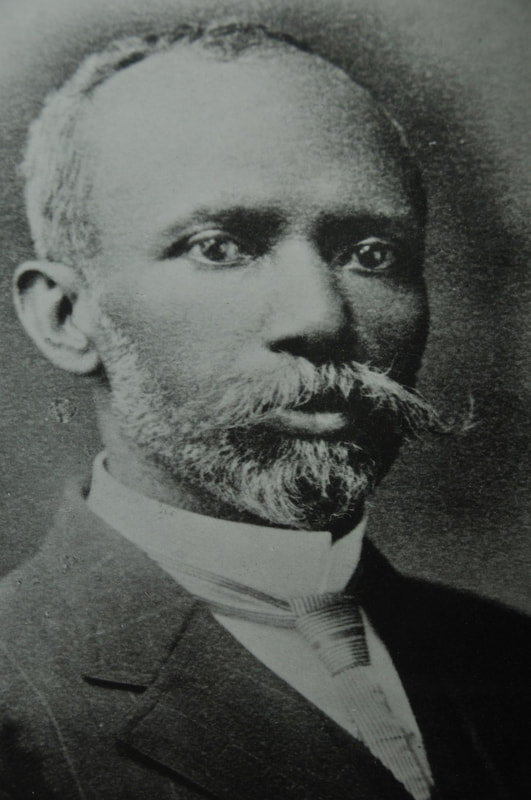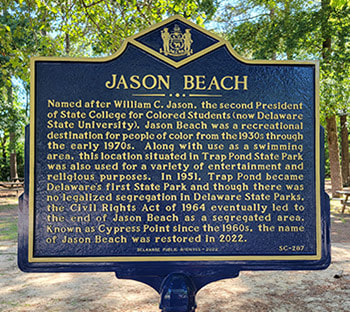|
Article by Dr. Clara Small William C. Jason Sr. (1859-1943) William Charles Jason was born October 21, 1859 in Trappe, Maryland to William Jason, an ordained minister and Mary Wing Jason, the daughter of Charles Wing, a Methodist clergyman, of Wilmington, Delaware. William Jason’s life was governed by his Christian heritage, a quest for knowledge, and a desire to educate others. William’s early years were spent in Easton and Cambridge, Maryland. After losing his mother at an early age, Jason and his three brothers were reared by their father. By the age of fifteen, Jason was apprenticed to a printer in Easton. He also learned to be a barber and opened his own shop in Easton at age eighteen. However, he desired to obtain an education, so he sold his barbershop and went to Lima, New York to attend Genesse Wesleyan Seminary, a Methodist Episcopal Preparatory School. His tuition was paid by him operating a barbershop in that area. Through hard work and persistence, he graduated cum laude from the seminary in 1884. His quest for knowledge was incomplete, so in the fall of 1884 he enrolled in Allegheny College at Meadville, Pennsylvania. From that institution, he earned a Bachelor of Arts degree in 1888 and a Master of Arts in 1889. In 1891, he earned a Bachelor of Divinity degree from Drew Theological Seminary in Madison, New Jersey. After obtaining his degree from Drew Seminary, William Jason was accepted into the Delaware Conference of the Methodist Episcopal Church. A few years later, Wiley University in Marshall, Texas bestowed upon him the degree of Doctor of Divinity. As a minister of the gospel, William Jason’s first charge was in Orange, New Jersey, and within four years, he had erected a church. An earlier apprenticeship as a printer in Easton, Maryland was instrumental in providing him the funds for the erection of the church. He also served as the pastor at the Tindley Temple at the Bainbridge Street Memorial Church and the Janes Church in Philadelphia. In 1896, he was released from his pastorate to become the President of Delaware State College (DSC) at Dover, now Delaware State University. The college was established on May 15, 1891, as the State College for Colored Students by the Delaware General Assembly under the provisions of the Morrill Act of 1890. That act provided for land grant colleges for Blacks in states that maintained separate educational facilities. Delaware State College opened its doors to students in 1892, and Dr. William C. Jason was elected as the second president, the first black president of the college, and the dominant personality during the first 25 years of its existence. When he took over the reins of the college, the school consisted only of the old mansion house of the Lockerman plantation and a stable which had formerly been the slave quarters. Dr. Jason assumed the task of developing “the college as an instrument for the upgrading of the Negro in Delaware.” One of his goals was to raise funds among Delaware Negroes to transform the old slave quarters into a chapel, because he wanted “to make over a place of misery and horror into a place of rejoicing.” His overall goals were to educate the youth of Delaware and for making Negro youth in Delaware aware of the opportunity for higher education; for hiring Alice Ruth Dunbar-Nelson, the wife of Paul Laurence Dunbar, the preeminent Black poet and author, to conduct the summer school for Negro teachers; for lobbying the state legislature for funding to operate Delaware State College and the summer school; and finally, for improving the quality of the faculty at the college. Dr. Jason hired the most highly trained and educated individuals to teach and educate future teachers despite the fact that he was not allocated adequate funds to accomplish the job. One of his highly respected teachers at the school, Pauline A. Young, stated that Dr. Jason was “expected to build academic and industrial agricultural curricula simultaneously without adequate funds, staff, or physical plant.” Dr. Jason served as president of the college for 28 years, from 1895 until 1923. During that period, he provided black schools in Kent and Sussex Counties with their first highly qualified teachers. In 1923, he resigned his presidency and returned to his first love, active ministry in the Delaware Conference. He offered his resignation only after he had seen the college grow to the point that he believed it could sustain itself under new leadership. Upon his return to the ministry, Dr. Jason served charges in Cheswold, Dover, Smyrna, and Milford, and in Maryland-St. Michaels, Oxford, Delmar, and the Centreville Circuit. In 1936, he returned to Delaware State College and served as Chaplain until his health began to fail and he resigned in1941, not just from being chaplain, but also from active duty in the Delaware Conference. Dr. Jason spent the latter days of his life not far from Delaware State College in a house he had built among the trees he had planted just across the bridge from the college. A week before he died, he calmly said that he “knew that his work was done.” He died July 8, 1943. Dr. William C. Jason was a beacon of light for the education of students, especially for black students throughout the state of Delaware, specifically to the lower counties of the state. In 1950, the William C. Jason Comprehensive High School was opened in Georgetown, Delaware to fill the educational vacuum for blacks in lower Delaware. It was funded through a bequest of the philanthropist, H. Fletcher Brown, who stipulated in his will that $250,000 of his estate be given to help build a Negro high school somewhere in the lower part of the state. The William C. Jason Comprehensive High School became the first African American secondary school in Sussex County. The school was a legacy to Dr. Jason’s commitment to prepare Negro youth for the future and to stress the value of strong character and morality. In June of 1967, when Delaware’s public schools were desegregated, Jason Comprehensive High School closed its doors and it later became a part of Delaware Technical and Community College. A second reminder of his legacy is that the library at Delaware State University is known as the William C. Jason Library, which also stands as a testament to his life’s work. Recently, Dr. William C. Jason was also remembered by another factor as well, Jason Beach. Jason Beach, located in Trap Pond State Park, outside of Laurel, Delaware, had been a recreational destination for the Black community in the mid-1900s and the beach was named after Dr. Jason, the longest serving president at Delaware State College, now, University. After the passage of the 1964 Civil Rights Act, Jason Beach was no longer for segregated recreation and entertainment and it became known as Cypress Point. However, on June 21, 2022, Governor John Carey, Natural Resources Secretary Shawn Garvin, some elected officials, and some area students gathered at the site on the Juneteenth holiday and unveiled a Delaware Public Archives historical marker and declared Jason Beach a historic site and returned it to its rightful name, of Jason Beach. In remembrance of its original name, some students and others were encouraged to research and learn the many accomplishments of Dr. William C. Jason. Jason Beach Marker
Delaware State Parks
0 Comments
Leave a Reply. |
Archives
July 2024
Categories |



 RSS Feed
RSS Feed
